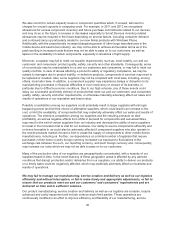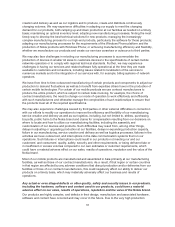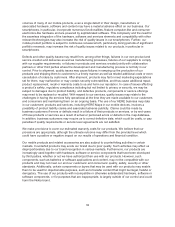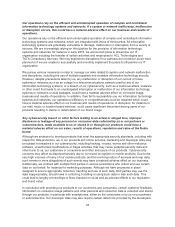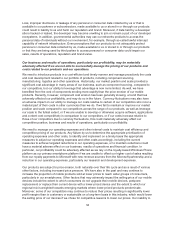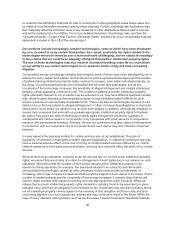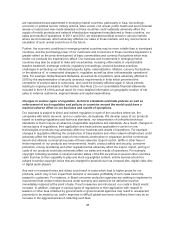Nokia 2012 Annual Report Download - page 40
Download and view the complete annual report
Please find page 40 of the 2012 Nokia annual report below. You can navigate through the pages in the report by either clicking on the pages listed below, or by using the keyword search tool below to find specific information within the annual report.Our expansion into the provision of services, including the activities of our HERE business, has
resulted in a variety of new regulatory issues and subjects us to increased regulatory scrutiny.
Moreover, our competitors have employed and will likely continue to employ significant resources to
shape the legal and regulatory regimes in countries where we have significant operations. Legislators
and regulators may make legal and regulatory changes or interpret and apply existing laws in ways
that make our services less appealing to the end users, require us to incur substantial costs, change
our business practices or prevent us from offering our services.
In line with changes in strategy, as well as in some cases a difficult political or business environment
and an increasingly complicated trade sanctions environment, Nokia and Nokia Siemens Networks
have reduced operations and have exited or are in the process of exiting certain countries, such as
Iran, or areas. Such actions may trigger additional investigations, including tax audits by authorities or
claims by contracting parties. The result of such investigations or claims may be difficult to predict and
could lead to lengthy disputes or fines or a settlement.
The impact of changes in or uncertainties related to regulation and trade policies could affect our
business and results of operations adversely even though the specific regulations do not always
directly apply to us or our products. In many parts of the world where we currently operate or seek to
expand our business, local practices and customs may be contrary to our code of conduct and could
violate anticorruption laws, including the US Foreign Corrupt Practices Act and the UK Bribery Act
2010 or EU and other applicable trade sanctions and embargoes. Our employees, or others who act on
our behalf, could violate policies and procedures intended to promote compliance with anticorruption
laws or trade sanctions. Violations of these laws by our employees or others who act on our behalf,
regardless of whether we participated in such acts or knew about such acts at certain levels of our
organization, could subject us and our employees to criminal or civil enforcement actions, including
fines or penalties, disgorgement of profits and suspension or disqualification from sales. Additionally,
violations of law or allegations of violations may result in the loss of reputation and business. Detecting,
investigating and resolving such situations may also result in significant costs, including the need to
engage external advisors, and consume significant time, attention and resources of our management.
As a global company, we are subject to various legislative frameworks and jurisdictions that regulate
fraud committed in the course of business operations and trade sanctions and as such the extent and
outcome of any proceedings is difficult to estimate. Further, our business and results of operations may
be adversely affected by regulation and trade policies favoring the local industry participants as well as
other measures with potentially protectionist objectives which host governments in different countries
may take, particularly in response to difficult global economic conditions.
An unfavorable outcome of litigation could have a material adverse effect on our business,
results of operations, financial condition and reputation.
We are a party to lawsuits in the normal course of our business. Litigation can be expensive, lengthy
and disruptive to normal business operations and divert the efforts of our management. Moreover, the
results of complex legal proceedings are difficult to predict. An unfavorable resolution of a particular
lawsuit could have a material adverse effect on our business, results of operations, financial condition
and reputation.
We record provisions for pending litigation when we determine that an unfavorable outcome is
probable and the amount of loss can be reasonably estimated. Due to the inherent uncertain nature of
litigation, the ultimate outcome or actual cost of settlement may vary materially from estimates. We
believe that our provisions for pending litigation are appropriate. The ultimate outcome, however, may
differ from the provided level which could have a positive or negative impact on our results of
operations and financial condition.
39



